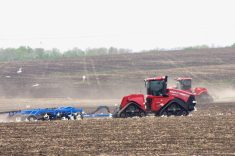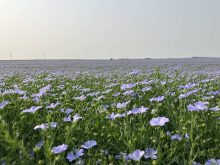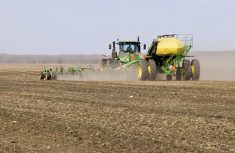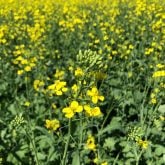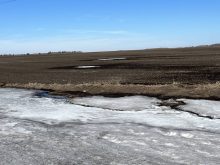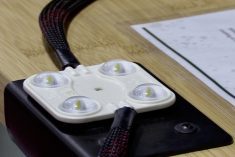Southwest Region
Scattered rain and snow over the past two weeks in the Southwest region brought some moisture to replenish the seedbed. Overall seedbed moisture conditions are optimum in much of the Southwest, but good rains are needed to replenish soil profile. Overwinter snow and runoff was below normal, with average winter temperatures 2 to 4 degrees higher than normal. Daytime temperatures in April have been cooler, preventing soil warming. There has been no surface runoff and many fields are dry, easing seeding operation. Some fields have wet spots in northern parts of the region.
Read Also

Manitoba sclerotinia picture mixed for 2025
Variations in weather and crop development in this year’s Manitoba canola fields make blanket sclerotinia outlooks hard to pin down
Seeding has started with spring wheat and peas. Major seeding progress will start this week. Fertilizer application and harrowing on cropland is underway. Forages and winter cereals are being top-dressed. Weeds are emerging slowly due to fluctuation in temperatures. Producers are planning to do pre-seed burn off and waiting for the right temperature.
Winter cereals are emerging well, but lack of snowmelt and dry soils are taking a toll on these crops. Fall rye is doing better than winter wheat. High market demand is leading to speculation that canola acres will increase this coming season across the Southwest. Soybean and corn acres may be down little bit due to moisture conditions. Most other crops acres would be stable in acreage share.
Pastures and hay ground remains dormant, with rain required to spur growth. Ranchers are keeping cattle on spring fields and in pens, with no reports of feed shortages and bales for sale. Producers have concerns about dry conditions and how pastures and hay land will progress this year. Dugouts are a concern in some areas as there was little to no spring runoff in some areas. Creeks are dry except in retention or low areas. Dugouts are 30 per cent full.
Northwest Region
Temperatures in the past week were generally cool throughout the region with warmer weather needed to increase soil temperatures. Daytime temperatures were highest around the southern part of the region however cooler overnight temperatures continued this past week. There remains some snow along fence lines and in the bush. Soil moisture is currently adequate to normal and available for germination of annual crops.
Depending on precipitation going forward, more is required, in most of the region, for crop growth.
Producers are readying equipment as fields are drying. Spring operations are limited to initial starts of harrowing, fertilizing and spraying around Roblin, Grandview and Swan River areas. Soil temperatures need to warm before a significant start to seeding takes place. Expectations are that seeding operations will start later in the week in the Northwest region. Good winter survival of winter cereals, clovers and alfalfa is expected.
Dugouts are full to adequate but with no spring run off may become depleted without more timely spring rains. Pasture and hay growth is slow with the cold evening temperatures.
Central Region
Topsoil moisture is dry given the poor snow cover and melt this spring. Spring runoff was poor having received below normal precipitation overwinter and below normal rainfall in April. Accumulated precipitation in April varies from 5 to 20mm with the eastern side of the region receiving the higher amounts.
Daytime temperatures have remained cool and below normal for the past two weeks while overnight temperatures continued to dip below freezing. Frost is out of the ground as found by soil sampling done and local weather stations soil sensors. Seeding started in the region the first week of April, but slowed as soils are still warming. Field access is very good with drier topsoil conditions prevailing.
Fertilizer applications progressed in selected fields and forage crops. Spring manure injection from intensive livestock operations are mostly complete given the favourable field conditions.
Winter wheat, fall rye and perennial ryegrass fields have de-hardened and growing slowly. Winter survival of those crops is good but establishment delayed due to the dry conditions of the fall. Recovery and growth is evident with minimal reseeding expected. Top-dress fertilizing of those crops is progressing well. Some reports of wheat, field peas and canola seeding done in the region. Diamondback moth traps are being set up this week.
Indications are that cereal acres will be reduced this year compared to 2020, while oilseeds are expected to increase given favourable prices and soybean acres should be similar to higher than last year. Potato planting is expected to start this week.
Winter annual and perennial weed growth is slow given the prevailing cool temperatures. Field preparation been limited to date west of the escarpment, while in the southern Red River Valley, a number of cereal crops are germinating. Seeding is done with the least amount of seedbed preparation to preserve topsoil moisture. Fertilizer floating continues in many areas.
Overall, there has been minimal runoff resulting in next to no dugout recharge. Water supplies are starting out poorer this spring than last spring and a good spring rain would be welcome.
Below normal temperatures and dry topsoil have delayed forage hay and pasture development with little growth so far. Once temperatures warm up regrowth will occur.
Eastern Region
Precipitation across the region over the last week showed zero or very limited accumulation. Overall, daytime and nighttime temperatures were often colder than normal. Soil temperatures at seeding depth on the warmest days last week were 6 to 8 C but quickly dropped off to the 0 to 2 C range at night. Soil temperatures on fields with heavier residue cover will be significantly colder. Soil moisture conditions on cropland across the region were rated as adequate for seeding and germination. Rainfall and snow earlier in the month made a big difference to soil moisture in the top 6 inches. Producers are still concerned about overall soil moisture status and hope for rain in May. In northern parts of the region, a few fields were noted with standing water in spots indicating areas of greater precipitation earlier this month. Most fields should be accessible this week.
Across the region, less than 5 per cent of winter wheat or fall rye acres appear to have winterkilled. Overall, stand condition was assessed as good. Most winter cereal growers have completed nitrogen applications wherever field access is possible. It should be noted that winter cereal acres in the region continue to be on the decline.
Early snowmelt in March 2021 meant that most manure application has been completed in the last few weeks with the manure being injected into the soil. Spring fertilizer is being floated on and incorporated, some spring banding of fertilizer has been reported as well. A limited amount of seeding occurred last week with a few fields of spring wheat going in. Producers have reported that they will be starting spring wheat seeding early this week with seeding becoming more general by the end of this week. Some early corn acres are also planned to go in by the end of the week.
Soil moisture conditions on hay and pasturelands are rated as adequate. Fertilizing of pasture, and hay fields in full swing in the cattle producing areas of the region. Livestock feeding on pasture is beginning to get cows out of corrals. Forage inventories running low in some areas. Dugouts that did not receive any runoff are at less than 50per cent capacity. Dugouts that received runoff are full. Availability of livestock water was reported as adequate for the region.
Interlake Region
Dry conditions continue – snowfall this past winter was again lower than normal. Most of the region received 30 to 40 per cent of normal or less. A portion of the north and northwest region received amounts of 40 to 50 per cent of normal. Woodlands received the lowest at 14 per cent of normal. Spring runoff was limited. A slow melt allowed moisture to soak in. Temperatures have been extremely variable in the past week, with highs up to 20 C, and overnight lows down to -10 C. Trace amounts of precipitation in the last week, with amounts of 2 mm or less.
After an early seeding start for a few, a welcome snowfall mid-April shut down field operations. Seeding is starting up as conditions allow, and will become more general by the end of the week. Frost is coming out of the ground, and soils are warming. Field conditions are much improved as compared to spring 2020. Minimal acres of unharvested crop remain, and most producers were able to complete intended tillage operations last fall. Good progress was also made with fall fertilization.
Prior to the snow, fertilizer applications were made to most winter wheat and fall rye acres, along with some forage seed fields, also hay and pasture. Fertilizer applications continue. Winter survival seems good, with little if any reports of winterkill to date.
Spring wheat continues to go in. The very earliest seeded is reported as poking through. A few peas are seeded. Other cereals will soon follow wheat. Conditions are good at present, with moisture to get crops going. Concern regarding lack of moisture lower in the soil profile continues.
More producers have moved to low disturbance seeding equipment. Many intend to go straight in, forgoing pre-seed tillage in order to preserve moisture.
There seems to be minimal if any change to seeding intentions, with different areas reporting slightly more sunflowers and flax, or a modest increase in canola or soybeans. A couple of reports of slightly more barley. Some areas will see slightly lower soybean acres, due to concern about dry conditions in lighter textured soil. For the most part, acres are holding, and producers are optimistic with good market prices. Most are in a good position with field preparations, and enough moisture to get the crop going.
Some dormant applied herbicide is down on forages. Pre-seed soil applied herbicides will start this week. Minimal pre-seed burnoff applications have been made, as weed growth has been limited with cool and the earlier dry conditions. Starting to see some green up of winter annuals.
Cold and dry conditions have hampered pasture and hay regrowth. Combined with late summer and fall grazing, plants have low carbohydrate root reserves for from which to regrow. At present, winter feed supplies are adequate, but shortages may arise if significant delays to cattle going on to pasture arise. Winter forage supplies were improved this past winter as compared to the previous year. Producers switched from annual crop to feed crops to make up anticipated shortfalls. Some herds were culled, to match feed supplies to number of animals. Dugout levels are low for this time of year, and rains are much needed for recharge.






